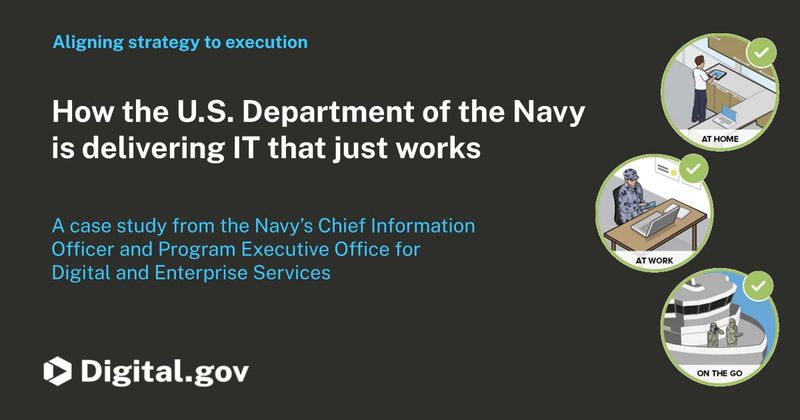Analytics
Measure and plan your site performance with analytics best practices and tools
Web analytics provide valuable insights into how users interact with a website. Use the data gained from web analytics to identify areas for improvement and make data-driven decisions. This can lead to a more user-friendly and engaging website, which can enhance trust and overall site performance.
Related Policy
M-10-22, Guidance for Online Use of Web Measurement and Customization Technologies (PDF, 130 KB, 9 pages, June 2010)

Analytics: Essential knowledge
-
How to build an analytics strategy
The Digital Analytics Program (DAP) provides a start-to-finish approach for assessing, reporting, and taking action using Digital.gov in a case study.
-
Video: Continuously improve your website by using customer feedback and web analytics: An IRS case study (length: 31:27)
Learn how you can use web analytics to make improvements to user experience.
-
An introduction to search
Follow search engine optimization (SEO) best practices to help search engines discover your content.
-
How to use web analytics to uncover cybersecurity incidents: A USAGov case study
Learn how you can take a deep dive into analytics and uncover phishing attempts or other improper use of your agency’s content, logo, or brand.
-
How to track performance
Use this step-by-step guide to choose metrics & tools, set budgets & goals, and add site tracking on your website.
Analytics events
Continuously improve your website by using customer feedback and web analytics: An IRS case study
How Effective Is Your Communication?
Analytics news
Making targeted improvements to NPS.gov: A case study from the National Park Service
NPS enhances user experience on NPS.gov by integrating Digital Analytics Program web analytics data and customer feedback from GSA Touchpoints.
Data.gov launches metrics tools
New Data.gov metrics dashboard provides information on most visited datasets, most downloaded files, most clicked outbound links, top search terms, and more.
Unsolicited data: A valuable resource for digital customer experience enhancement
Optimizing federal service touchpoints involves analyzing both actively-sought and spontaneous feedback, introducing new metrics and data points.
How the U.S. Department of the Navy is delivering IT that just works
The U.S. Navy’s Program Executive Office for Digital and Enterprise Services is working to revolutionize how information technology is acquired.
Equity study reaches 4,000 participants
Launched last fall, the General Services Administration equity study on remote identity proofing aims to determine if biases exist in the algorithms used for online identity verification. The study has now reached its goal of recruiting 4,000 participants from diverse communities, and experts are ready to begin analysis of the data. Learn how the team at GSA plans to conduct this data analysis, and how their findings will lead to improved equitable services delivery in technology across the government.— via General Services Administration

Resources on Analytics
-
An introduction to customer experience
Understand what customer experience (CX) is and how to leverage customer feedback and analytics to enhance the public’s experience when interacting with government services.
-
An introduction to privacy
Introductory guidance on implementing privacy protections for users of federal websites.
-
An introduction to analytics
Learn how to set performance goals, and identify specific KPIs and targets to measure and meet them, using web analytics.
-
Introduction to QR codes
What is a QR code and how can you create one? What are some alternatives to using QR codes? This introductory resource will help you explore your options.
-
Web Analytics Playbook
Use these plays to help strategize how your team can most effectively use web analytics for your website and target audience.
-
How to Build an Analytics Strategy
A case study using Digital.gov as an example of how to assess, report, and take action using web analytics as part of an analytics strategy.
-
Requirements for delivering a digital-first public experience
Learn how to implement 21st Century IDEA to design and deliver better websites and digital services.
Tools and Services
-
Digital Dashboard
Measures how U.S. government domains are following best practices for federal websites.
-
Analytics.USA.gov
A window into how people are interacting with the government online. Powered by the Digital Analytics Program (DAP)
-
Digital Analytics Program
A free analytics tool for measuring digital services in the federal government.
More News and Events on Analytics
283 posts
Making targeted improvements to NPS.gov: A case study from the National Park Service
NPS enhances user experience on NPS.gov by integrating Digital Analytics Program web analytics data and customer feedback from GSA Touchpoints.
Data.gov launches metrics tools
New Data.gov metrics dashboard provides information on most visited datasets, most downloaded files, most clicked outbound links, top search terms, and more.
Unsolicited data: A valuable resource for digital customer experience enhancement
Optimizing federal service touchpoints involves analyzing both actively-sought and spontaneous feedback, introducing new metrics and data points.
How the U.S. Department of the Navy is delivering IT that just works
The U.S. Navy’s Program Executive Office for Digital and Enterprise Services is working to revolutionize how information technology is acquired.
Equity study reaches 4,000 participants
Launched last fall, the General Services Administration equity study on remote identity proofing aims to determine if biases exist in the algorithms used for online identity verification. The study has now reached its goal of recruiting 4,000 participants from diverse communities, and experts are ready to begin analysis of the data. Learn how the team at GSA plans to conduct this data analysis, and how their findings will lead to improved equitable services delivery in technology across the government.— via General Services Administration

FedRAMP governance
The Federal Risk and Authorization Management Program (FedRAMP) has recently updated its governance structure to better serve its customers. Learn about their recently-formed FedRAMP Board, composed of federal executives; the FedRAMP Technical Advisory Group (TAG), composed of technology experts; and updates made to the Federal Security Cloud Advisory Committee (FSCAC). These groups collectively aim to strengthen and expand FedRAMP’s cloud service capabilities.— via FedRAMP

One year with the new USAGov
It has been a year since USA.gov and USAGov en Español were relaunched using human-centered design principles. Using task backlog, the USAGov team has addressed content gaps, improved discoverability, and implemented technical updates. Through usability tests, visitor comments, and click behavior the team was able to unravel and respond to user feedback and unmet needs, leading to noticeable increases in visitor satisfaction and task accomplishment. Moving forward, the focus will shift to enhancing public engagement with the government, improving the search for benefits-related content, and exploring interactive and personalized user experiences.— via USA.gov

Creating a blueprint for quality: How the PX Contact Center helps agents grow their skills
Every day, live agents at USA.gov’s Public Experience (PX) Contact Center answer questions from the public about government benefits and services. Learn how the PX Contact Center develops a workforce of excellent agents, using immersive onboarding, tailored and continuous training, feedback loops, and calibration meetings to empower their agents to deliver accurate information. USA.gov’s system for employee and contact center management ensures that every customer interaction leaves a lasting impact.— via USA.gov

Google Analytics 4: Transition strategies for federal websites
Learn how the Open Data, Design, and Development (ODDD) team at the Department of the Interior (DOI) transitioned from Google Analytics - Universal Analytics to Google Analytics 4! Discover how the ODDD team coordinated with the Digital Analytics Program, developed explorations (instead of custom reports), and set up their own DOI agency property.— via Office of Natural Resources Revenue

Progress towards delivering a digital-first public experience
Each year, more than 400 million individuals, families, businesses, organizations, and local governments get information and services from about 430 federal agencies and sub-agencies. The Biden-Harris administration is driving a bold vision for how government agencies serve their customers digitally with OMB’s ten-year roadmap for a modern digital experience. Agencies have already made significant strides. Learn about recent successes by the IRS, CDC, NASA, and FEMA, and how OMB will continue to collaborate with agencies to ensure ongoing improvement in digital government services.— via The White House

Delivering seamless customer journeys
GSA shares a 4-step process used to measure and analyze related websites, and additional plans to improve customers’ digital experience.
Determining the true value of a website: A GSA case study
GSA has developed a composite indicator to visualize six key components of website success.
How USAGov uses data to improve content
Each month, USAGov’s content designers spend many hours ensuring that the content on USA.gov and USAGov en Español is up-to-date, accurate, and meets user needs. Learn how their team does holistic reviews of each topic section based on a rolling calendar with the goal of updating all content at least every 6 months.— via USA.gov

Search.gov year in review: 2023 report
Learn what types of information people searched for on federal websites in 2023, see emerging trends the team is exploring to improve customers’ search experience in 2024, and check out three new updates. The data tab provides insightful summaries for 13 popular topic areas—and lists the public’s top 25 search terms, in their own words, for each.— via Search.gov

Spring 2024 Community Summit
Customer experience: beyond surveys
Want to measure customer experience? Surveys aren’t the only way! Consider these guiding questions to help your team select an approach based on what you want to learn.— via 18F

Maximizing impact of federal websites: Integrating metrics with annual goals and policies
The Open Data, Design, and Development (ODDD) team discusses how OMB’s recent memo, Delivering a Digital-First Public Experience (M-23-22), inspired them to reassess their metrics plan to harmonize with policies governing federal public websites.— via Office of Natural Resources Revenue

Defining benchmarks and targets for intranet KPIs
Discover the keys to intranet success by harmonizing objectives, metrics, benchmarks, and targets. Elevate your organization’s intranet to new heights!
Why the American People Deserve a Digital Government
OMB released new policy guidance for government that includes a variety of actions and standards to help federal agencies design, develop, and deliver modern websites and digital services. Memo M-23-22, Delivering a Digital-First Public Experience, will make it seamless for the public to obtain government information and services online, and help agencies fully implement the 21st Century Integrated Digital Experience Act (21st Century IDEA).— via The White House

Creating a functional inventory database for website content audits
The Office of Natural Resources Revenue recently completed a site-wide content inventory and audit. Here is how they modified an existing content inventory spreadsheet to act as a functional database for enhancing content throughout the site.— via Office of Natural Resources Revenue












